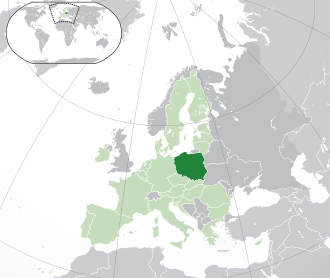Poland





Poland, officially known as the Republic of Poland, is a country located in Central Europe. It is bordered by Germany to the west; the Czech Republic and Slovakia to the south; Ukraine, Belarus, and Lithuania to the east; and the Baltic Sea and Kaliningrad Oblast (a Russian exclave) to the north. The country also shares maritime borders with Denmark and Sweden. With a population of over 38 million people, Poland is the fifth-most populous member state of the European Union. Its capital and largest city is Warsaw.
History[edit]
The history of Poland is rooted in the arrival of the Slavs, who gave Poland its name, in the region. The country became a kingdom in 1025 and underwent significant territorial changes in the centuries that followed. Poland formed a union with Lithuania in 1386, through the marriage of Queen Jadwiga of Poland and Grand Duke Jogaila of Lithuania. The Polish-Lithuanian Commonwealth, established in 1569, was a notable period of prosperity and cultural development. However, the country was partitioned in the late 18th century by the neighboring powers of Prussia, Russia, and Austria, disappearing from the map until the end of World War I, when it regained independence.
During World War II, Poland was invaded by Germany and the Soviet Union, leading to immense suffering and the loss of millions of lives. After the war, Poland became a Soviet satellite state, but it was among the first to break away from Soviet control, transitioning to a democratic government in 1989.
Geography[edit]
Poland covers an area of approximately 312,696 square kilometers, making it the ninth-largest country in Europe. Its diverse landscape ranges from the sandy beaches along the Baltic Sea coast to the Sudetes and Carpathian Mountains in the south. The country is also home to over a thousand lakes, mostly in the northern region of the Masurian Lake District.
Economy[edit]
Poland has a high-income economy and is considered a regional power in Central Europe. It has a diverse economy that includes sectors like manufacturing, mining, agriculture, and services. The country is a significant producer of coal and has large reserves of natural gas and oil. Poland's economy has been growing steadily, with improvements in sectors such as information technology and engineering. It is also a member of the European Union (EU), the World Trade Organization (WTO), and the Organization for Economic Co-operation and Development (OECD).
Culture[edit]
Polish culture has been influenced by both Eastern and Western traditions. Poland is known for its contributions to literature, music, cinema, and art. The country has produced several notable figures, including composer Frédéric Chopin, scientist Marie Curie, and filmmaker Andrzej Wajda. Poland's cultural heritage is also reflected in its festivals, traditions, and cuisine, which includes dishes like pierogi, kielbasa, and bigos.
Government and Politics[edit]
Poland is a parliamentary republic with a multi-party system. The President of Poland is the head of state, while the Prime Minister is the head of government. The Polish parliament is bicameral, consisting of the Sejm (lower house) and the Senate (upper house). Poland is a member of international organizations such as the United Nations, NATO, and the European Union, playing an active role in European and global affairs.
Education and Science[edit]
Poland has a well-developed education system, with a history of significant contributions to global science and technology. The country's education system is divided into primary, secondary, and tertiary levels, with several universities and institutions that are recognized internationally. Poland has been home to many notable scientists and scholars, including Nicolaus Copernicus and Marie Curie, who have made significant contributions to their fields.
Ad. Transform your life with W8MD's Budget GLP-1 injections from $75


W8MD offers a medical weight loss program to lose weight in Philadelphia. Our physician-supervised medical weight loss provides:
- Weight loss injections in NYC (generic and brand names):
- Zepbound / Mounjaro, Wegovy / Ozempic, Saxenda
- Most insurances accepted or discounted self-pay rates. We will obtain insurance prior authorizations if needed.
- Generic GLP1 weight loss injections from $75 for the starting dose.
- Also offer prescription weight loss medications including Phentermine, Qsymia, Diethylpropion, Contrave etc.
NYC weight loss doctor appointmentsNYC weight loss doctor appointments
Start your NYC weight loss journey today at our NYC medical weight loss and Philadelphia medical weight loss clinics.
- Call 718-946-5500 to lose weight in NYC or for medical weight loss in Philadelphia 215-676-2334.
- Tags:NYC medical weight loss, Philadelphia lose weight Zepbound NYC, Budget GLP1 weight loss injections, Wegovy Philadelphia, Wegovy NYC, Philadelphia medical weight loss, Brookly weight loss and Wegovy NYC
|
WikiMD's Wellness Encyclopedia |
| Let Food Be Thy Medicine Medicine Thy Food - Hippocrates |
Medical Disclaimer: WikiMD is not a substitute for professional medical advice. The information on WikiMD is provided as an information resource only, may be incorrect, outdated or misleading, and is not to be used or relied on for any diagnostic or treatment purposes. Please consult your health care provider before making any healthcare decisions or for guidance about a specific medical condition. WikiMD expressly disclaims responsibility, and shall have no liability, for any damages, loss, injury, or liability whatsoever suffered as a result of your reliance on the information contained in this site. By visiting this site you agree to the foregoing terms and conditions, which may from time to time be changed or supplemented by WikiMD. If you do not agree to the foregoing terms and conditions, you should not enter or use this site. See full disclaimer.
Credits:Most images are courtesy of Wikimedia commons, and templates, categories Wikipedia, licensed under CC BY SA or similar.
Translate this page: - East Asian
中文,
日本,
한국어,
South Asian
हिन्दी,
தமிழ்,
తెలుగు,
Urdu,
ಕನ್ನಡ,
Southeast Asian
Indonesian,
Vietnamese,
Thai,
မြန်မာဘာသာ,
বাংলা
European
español,
Deutsch,
français,
Greek,
português do Brasil,
polski,
română,
русский,
Nederlands,
norsk,
svenska,
suomi,
Italian
Middle Eastern & African
عربى,
Turkish,
Persian,
Hebrew,
Afrikaans,
isiZulu,
Kiswahili,
Other
Bulgarian,
Hungarian,
Czech,
Swedish,
മലയാളം,
मराठी,
ਪੰਜਾਬੀ,
ગુજરાતી,
Portuguese,
Ukrainian
